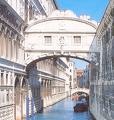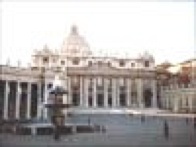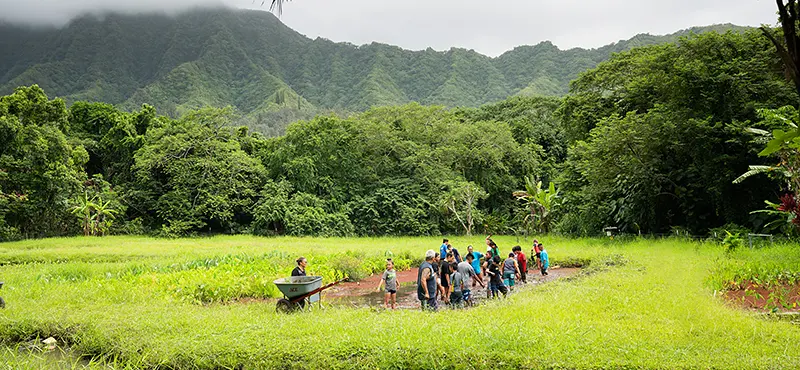Pauahi’s European Travel Journal 1875-1876
Italy
Sources: Pauahi by George Kanahele, Chapter 5: Revelations of an Odyssey
Student transcriptions from Ka Moi, 1935-37
Transcriptions of Dani Gardner, KSG 1961
Please cite: Kamehameha Schools Archives when using information from this website
Disclaimer: all images of Europe are from the Internet to enhance the text
Friday, October 9, 1936 - Ka Mo’i article: Bishops Entertained By Nobility At Trieste; Enjoy the Adriatic
Tuesday December 7
Yesterday, Bown Benko called to see us, and a few minutes after, Admiral von Pete [Petz] also called. They both gave us a hearty welcome to Trieste. In about an hour, we all went to the admiral’s house to call on the Baroness von Pete [Petz]. We were glad to meet her and Mrs. Jourhoto for we all spoke English [and fortunate for us, she spoke English]. So we had a very pleasant visit. She is a large, stout, good looking woman, a Russian by birth. Their rooms were handsomely jittered [fitted] up with many trophies of the admiral’s visit around the world.
We returned to our hotel and found Mr. Pitner, one of the Donan [Donau] officers, whom we had nine at home awaiting [us]. He had a great deal to say of their stay in Honolulu. Soon after the baron [Benko] came in to take us to Misamax [Miramar]. The residence of Maximillian of Mexico, and also to deliver to us a very kind invitation from the Baroness Sutteroths, wife of the German Consul General to take tea with them.
The drive out was very disagreeable, cold and windy; but we were well repaid for the visit. The chateau is kept in the most admirable order. The grounds neat and tasteful, with lovely anmuet [avenues] and shaded walks and terraced flower beds, and vineyards in the rear of the garden, with fountains here and there. the blue waters of the Adriatic dashing against the embankment of the chateau presented a most charming appearance. We went inside it and walked through the whole of the lower part [suite] of apartments, and up the second story where are the guest and state apartments. All of which were fitted up in the most exquisite manner. In keeping with various uses in which there [they] were interiored [intended]. The view from the castle terrace is lovely. We took a short drive after returning to town. In the evening, we went to the Baroness Sutteroths, who with her husband kindly received us. We spent out most delightful evening with them [Met there]. His Royal Highness the Archduke William of Wurtemburg, who we at once recognized as the gentleman who sits nearly opposite us at the table d’hote at the hotel. The Baroness Sennoy (?) [a] Styrian, Mr. and Mrs. Gurmans [Guch?mans], very charming people, etc. [the] baroness and five or six others Friday [Today], Baron and Baroness Sutteroths, Hon [Herr] and Fran [Frau] Gen [Gu–].
Admiral and Baroness von Pete [Petz] called to see us and also the Baroness G. who is staying at this hotel. At three o’clock we dined with Admiral and Baroness von Pete [the von Petz’s], Baron Benko, Mr. Pitner, and another gentleman whose name I do not remember, besides madame –. The daughters of the admiral were there. It was quite a [sociable dinner (party) and very pleasant.
Friday, October 16, 1936 - Ka Mo’i article: Mrs. Bishop Thrilled By Ride In Gondola Through Italian CanalsArmans [Cormons],
Wednesday 8
We left Trieste at 6 this morning. At Nabesina [Nabresina], we waited one hour and more—and at this home [horrid] place only about 15 miles. I should think from the latter [letter]; we are to remain two hours more. For the Lord only knows who reasons. These Italians have a queer way of analyzing [arranging] things. It is very cold yet, but the winds are not as sharp as at Trieste. The sky, however, is a s clear and blue as that of my dear native land.
Venice p.m.
After a tedious journey of ten hours, we at last arrived at the Casino Della Strand Ferrataiest [Stazimo della Strada Fenata] at 4 p.m. The commissionary [commissionare] from the Hotel Royal Ganieli [Hotel Royal Danieli] was waiting for passengers and as that was our destination, we embarked at the foot of the staircase of the station in the gondola, feeling very strange at this mode [&] of being conveyed to the hotel. Everything I had heard [read] of Venice of her glory, her magnificent [magnificence] and her pride in days gone by, came up before me and I could hardly believe that I was really looking at the homes of their people, who made Venice famous [&] envied. The boatman steered one [our] gondola a short distance through [thro’] the Iran [Grand] canal, and just as we neared the Rialto, we suddenly turned to the left and were towed [rowed] through [thro’] lanes as it were—and turned sharp corners, until we found ourselves under the famous bridge of Sighs. The police [palace] of the force [Doge] on one side; the prison on the other. On the other [another] turn brought us to the front of the hotel and up the steps at the side entrance. The whole scene was like a dream. This hotel, I believe, was once a palace [belonging]

Friday, October 23, 1936 - Ka Mo’i article: “Voyage of Discovery” Proved Exciting To Bernice P. Bishop
We went this morning to the Phoris [photo’s] to have our pictures taken, afterwards took a guide, hired a gondola and towed [rowed] up the Grand Canal on a “Voyage of Discovery.” Landed and inspected the churches [church] of La Maria Dello Saliste [S. Maria della Salute] on the Grand Canal. In it are paintings by Literian [Titian], Lintoretts [Tintoretto], and a group in marble on the high altar of the Virgin vanishing [banishing] the demons of the plague. The pillars or columns by which the vaunting [vaulting] of the choir is supported are from a Roman temple at the Pola. On the way the guide pointed out to us the different places which were once owned by the noble families of Venice. The Grand Canal being the street of the nobility [Nobili], the ancient aristocracy of Venice. Passed under the Rialto to the Gli Srabei [Scalzi], a most sumptuous church, belonging to the order of barefooted monks near the railway station. The interior of this church, the high altar, side altars, columns, railings, doors, the floors made of marble of all colors, brought from the coast [east] of Africa and from England [Europe]. There were two pieces of pink marble made to represent [two] rugs [&] with yellow fringes are [all] of marble; thrown carelessly as it were over the windows and on them were cushions, also made of the same colored marble. They were as natural as possible. On each side of one of the altars is a door most beautifully inlaid with florentine mosaic. One-half of which is left; is lightly [slightly] parted and appeared as if they had just been opened. They were superior [superb]. We again took our gondola and returning stopped at the Lrari [Frari], a church belonging to the Franciscans. The interior is plain, but very lofty. It contains many monuments, sculptures, and pictures. The Mosleum [mausoleum] of Canova and that of Litian (Titian) are both in this church—The monument to the former was the one he had planned for the tomb of Titian and which is similar to the one he executed for the Archduchess Maria Christiana at Vienna, but after his death, his admirers erected it to his own honor. That of Litian [Titian] erected by Emperor Fredrich [Ferd.] I. From this, we towed [rowed] to the Gloss [glass] factory and seen the workmen making gloss [glass] beads. Baskets [etc.] are —landed at the Rialto bridge, dismissed our gondola and walked to the fruit and vegetable market, to the Rialto where the laws of the republic were formerly promulgated. Near by the house of Shakespeare’s Shylock crossed the bridge of the Rialto, a very giant [quaint] structure with three streets, the middle being the most aristocratic, on each side were rows of shops, goods exhibited outside. Came through the Pussaria [Frezzeria] to the Prasse [Piazza] of Saint Mark. Inspected the interior, which is mostly covered with mosiam [mosaic] work. Pillars without numbers of all kinds of marble. Behind the high altar are four spiral columns of alabaster, two of which. the left colored ones, are semi-transparent. Over the high altar is a canopy of verde-antico [verde antico] and beneath it is the relico [relics] of Saint Mark.

Friday, October 30, 1936 - Ka Mo’i article: L. Liovannie Paolo [S. Giovanni e Paolo] Church Seen By Mrs. Bishop At Grand Canal
Friday, November 6, 1936 - Ka Mo’i article: Rome, Venice, Naples Visited By Mrs. Bishop On Journey of Italy
Friday, November 13, 1936 - Ka Mo’i article: Pronpeiri [Pompeii], Buried City, Reveals Ancient Culture to Mrs. Bishop
We soon perceived a change of climate. The further south we moved [neared], the warmer and milder it became. We passed the old city of Sapua [Capua], the Versailles of Naples. Through the villages of Caserta, not far from the railroad station is the palace, an immense structure built by Charles III, and arrived in this city after day [dark]; drove to the hotel Vittoria, where we are now.
Wednesday the 15th
We took a cab after breakfast and drove through the Via Cattarina [Catarina], passed the Royal Palace and to the Via Roma to Capodimonto [Capodimonte], one of the royal villas. There is a large palace in which is a collection of paintings, mostly modern, and stationary [statuary] no other works of art; but is not used as a residence. the gardens attached are very fine. As you enter the gateway, there is a semi-circle opening before you, surrounded on all sides by flowers and shrubs, and from this radiates three avenues in straight lines as far as the eye could see, hedged by trees, and beyond the forest the effect was very beautiful. In the afternoon went over across the way from our hotel to the Villa Realiato [Reale] to see the people and to hear the band. The Chiasa [Chiaia’] which bounds the Villa Realiato [Reale] on one side is a favorite drive of the fashionable world of Naples. They have fine equipages [carriages] and horses and sometimes [of] a pleasant afternoon. The carriages are so thick as to hold four abreast. It is a very gay and animating scene. Yesterday [16] as early as we could get away, we took a carriage with two horses, and drove to [italy-pompeii] Pronpeiri [Pompeii], a distance of 14 miles where we spent the day in rambling about this unearthed city. So replito [replete] with interest of the past race of people who have their own joys and sorrows but in a moment were buried out of sight by the eruptions [erupting] of Vesuvius and who remained for centuries unknown until discovered by accident. Most of the frescoes and murole [mural] paintings on [and] articles of value found here have to be removed to the museum of [at] Naples; but there are yet many frescoes remaining on the walls of houses [and marble fountains in the houses] of the rich. The paved streets with high stepping stones at the corners, and the ruts made by the carriages are just the same now as on the day of the calamity, the [blank space] of August 79 A.D. Now no sounds are heard in the silent streets, but the steps of the tourists from other lands, and the noises of the workmen who are still excavating the city, only about one-third is yet unearthed, and we noticed yesterday the workmen were excavating a large house

Friday, November 20, 1936 - Ka Mo’i article: Mrs. Bishop Visits Herculaneum In Latest Sightseeing Excursion
Friday, December 4, 1936 - Ka Mo’i article: Bernice P. Bishop Tells of Arts When Visiting Museum Of Naples
Friday, January 15, 1937 - Ka Mo’i article: Young Ladies Dance Tarantella For Mrs. Bishop While in Italy
Friday, January 22, 1937 - Ka Mo’i article: Mrs. Pauahi Bishop Celebrates Christmas Holidays In Rome
Rome, Wednesday 22
There was another old lady, a Miss Merritt, an English lady, who was once a governess of the old contessa Contesse]. There were also present a young officer and his sister, a friend of the family. We spent a delightful evening with them and taught them the game of euchre. We returned home after 11 o’clock through the Via Roma, which was still full of life, for the fair continued to late at night.
Rome, December 24
We are in Rome once more; the climate is not as agreeable as that of Naples. We left the latter city yesterday at [about] 1 o’clock and arrived here at 9 p.m. in a fog, cold and damp. I am feeling very unwell today, and tonight is Christmas eve.
Monday, December 27
On Christmas day I was ill in bed with a most dreadful headache and a very bad cold contracted in Naples. It was dismal enough to be confined in bed on such a day. Mrs. [Mr.] B. went to St. Peter’s, where high mass was performed by a cardinal. The singing was god. A great crowd was there. Yesterday morning, I felt better, but late in the afternoon, my headache came on again very severely and one of the maids said that I should have a doctor and went to fetch one close by. He is an Italian, but speaks English very well. He came to see me and said my trouble was rheumatic affection. He gave me some medicine and told me to take a hot mustard bath. And today, I am feeling much better and so ventured out to see the church of St. Giovanni, the Laterano, and to hear the music; it being St. John’s day, the patron saint of the church.
Friday, January 29, 1937 - Ka Mo’i article: Visit At Borghese Is Enjoyed By Benefactress Princess P. Bishop
February 12, 1937 - Ka Mo’i article: Bishops Travel Through Rome Visiting Spots Of Fine Interest
Friday, February 19, 1937 - Ka Mo’i article: Mrs. Bishop Makes Various Trips Through Exciting Places in Italy
Friday, February 26, 1937 - Ka Mo’i article: Church of St. Giovanni Is Visited By Kam’s Benefactress
Friday, March 5, 1937 - Ka Mo’i article: Mrs. Bishopʻs Diary Relates Trip to Villa Volkonsky; Visits Pope
Monday 10th
After a tedious journey of ten hours, we at last arrived at the Casino Della Strand Ferrataiest [Stazimo della Strada Fenata] at 4 p.m. The commissionary [commissionare] from the Hotel Royal Ganieli [Hotel Royal Danieli] was waiting for passengers and as that was our destination, we embarked at the foot of the staircase of the station in the gondola, feeling very strange at this mode [&] of being conveyed to the hotel. Everything I had heard [read] of Venice of her glory, her magnificent [magnificence] and her pride in days gone by, came up before me and I could hardly believe that I was really looking at the homes of their people, who made Venice famous [&] envied. The boatman steered one [our] gondola a short distance through [thro’] the Iran [Grand] canal, and just as we neared the Rialto, we suddenly turned to the left and were towed [rowed] through [thro’] lanes as it were—and turned sharp corners, until we found ourselves under the famous bridge of Sighs. The police [palace] of the force [Doge] on one side; the prison on the other. On the other [another] turn brought us to the front of the hotel and up the steps at the side entrance. The whole scene was like a dream. This hotel, I believe, was once a palace [belonging]
















